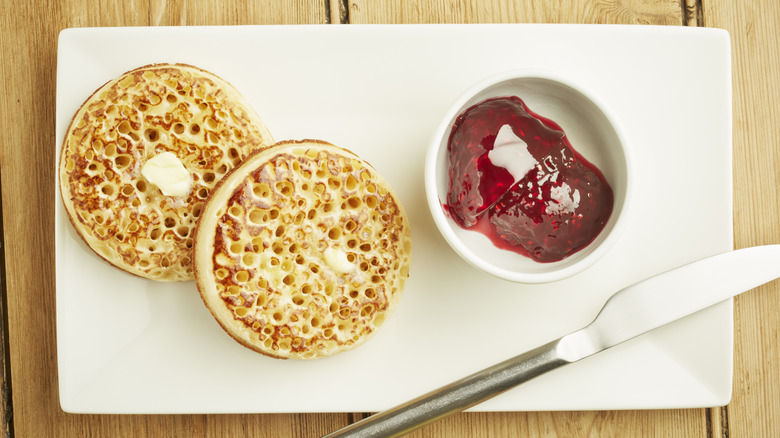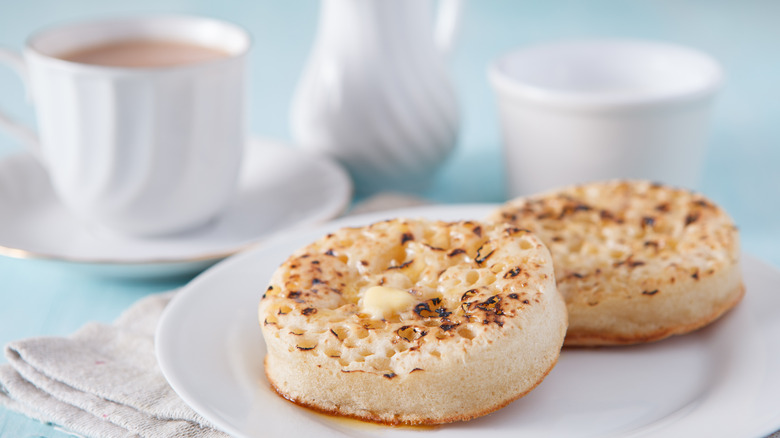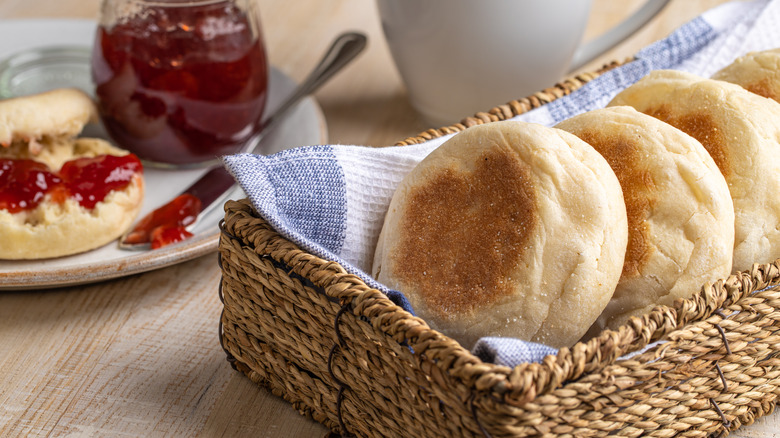Sorry, But Crumpets And English Muffins Are Not The Same
Many Americans are familiar with the signature "nooks and crannies" of an English muffin. It's the deep holes and pockets in these round treats that soak up butter and jam so deliciously, and any U.S. resident who's seen a British crumpet has likely noticed that these baked goods look exceedingly similar. Popular in places like the United Kingdom, Canada, New Zealand, and South Africa, crumpets look so similar to their "muffin" counterparts that you might assume the two are the same. However, as it turns out, crumpets and English muffins are two different foods.
Both of these teatime snacks are considered "griddle cakes," as they're cooked on a stovetop or griddle rather than baked in an oven, but while the crumpet is British-born, the English muffin was (ironically) created in New York City, a full century after crumpets were invented. And while it's common practice to slice an English muffin into two pieces in order to toast both sides, crumpets are thinner, and don't need to be sliced at all to be eaten easily. Both breads are great for breakfast, smeared with cream cheese, chocolate hazelnut spread, preserves, and more, but their list of differences is as long as their list of similarities.
All about crumpets
The first crumpets, which were made in 17th century Britain, were more like thin pancakes, made with flour, eggs, and milk. It wasn't until the 19th century that they came to resemble what we know them as today: raised rounds of bread with yeast and baking powder in the recipe. The dough mixture is poured into ring-shaped molds, which hold the batter in place, and the crumpets are usually griddled on one side only, leaving the other side with a spongy texture. Toppings are spread on the softer side, so that they can melt and run into the deep pockets.
In Britain, crumpets are just as commonly eaten during tea time as they are for breakfast (accompanied by jam and clotted cream, of course). If you try one, you might notice that they are chewier and less dense than English muffins. Although it's English muffins that are typically used to make eggs Benedict, you could absolutely use crumpets instead, or treat these soft little circles like mini pancakes. After warming them, spread with butter and top with syrup and fresh fruit. The soft texture also makes them perfect for making easy-to-eat sandwiches.
The unique traits of English muffins
It's quite possible that English muffins look so similar to crumpets because they were invented by English expat Samuel Bath Thomas (yup, the same Mr. Thomas of the well-known brand Thomas' English Muffins). Thomas created these famous treats in the 1800s, after he relocated to New York. Funnily enough, some U.K. establishments call his invention "American Muffins."
English muffin batter is noticeably thicker and firmer than crumpet dough, doesn't include any milk, and is raised by yeast only. They are cooked on the stove, as well, but on both sides, and are often sprinkled with cornmeal or semolina flour to keep them from sticking to the griddle. Because the dough is sturdy, molds aren't usually needed to create the round shape. Before they are sliced, you can't see the crevices that are inside these handheld delights, so they're almost always cut in half.
English muffins can be toasted and eaten just like crumpets, or filled with eggs, meat, veggies, and cheese to make delicious breakfast sandwiches. They also work great for making mini pizzas, tuna melts, and can even be used as burger buns when you're in a pinch. If you want a breakfast treat similar to crumpet "pancakes," try using English muffins to make French toast (just imagine how much butter could be entrapped in those nooks).



